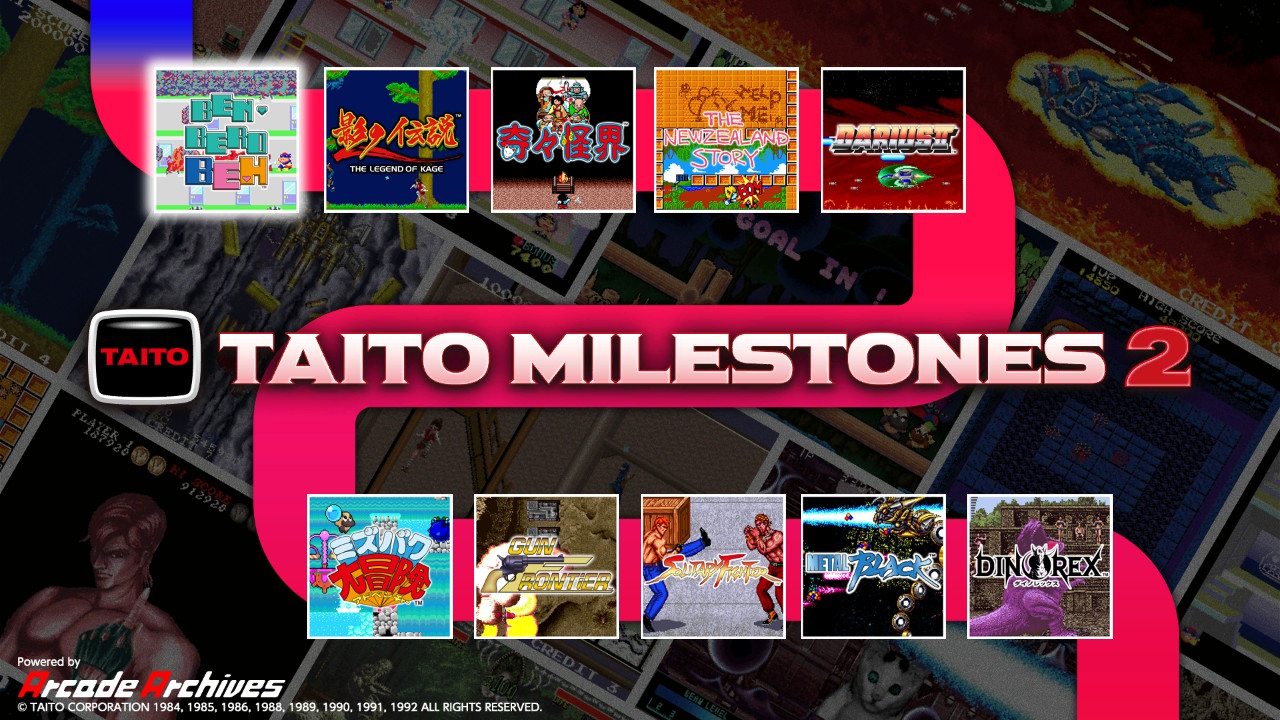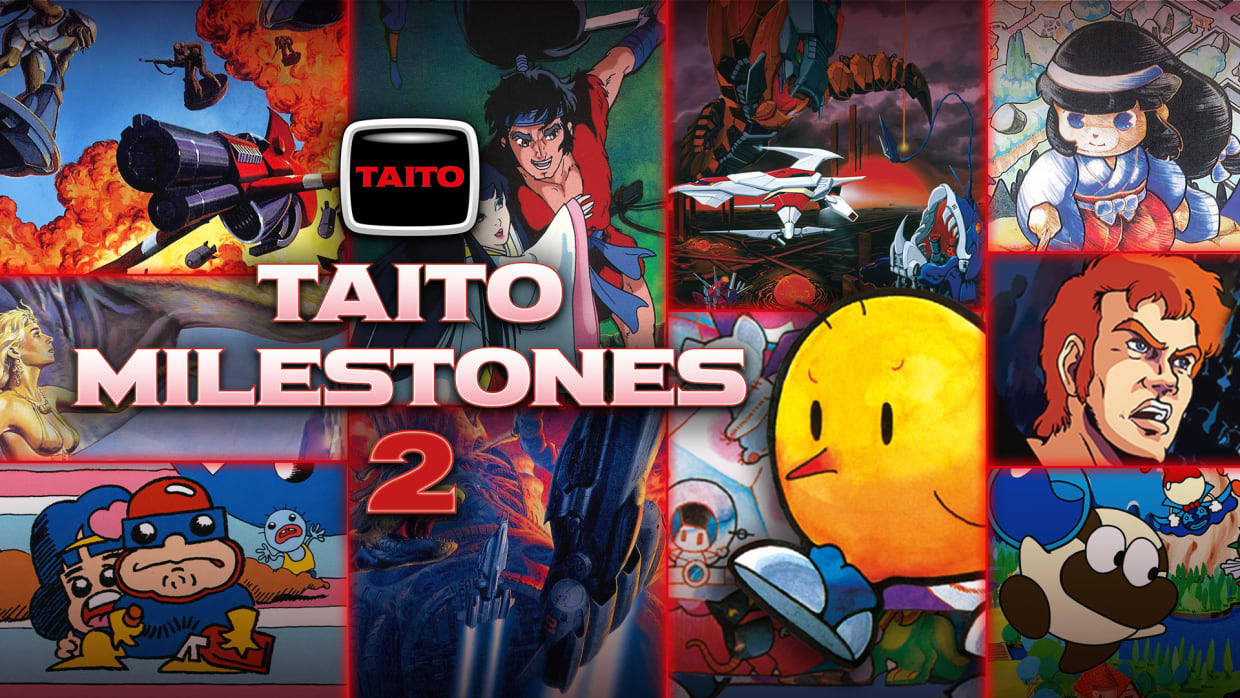TAITO Milestones 2
Taito Milestones 2 comes complete with ten titles, spanning an eight-year period from the mid-eighties to the early nineties. While Taito is known for its flagship series, Bubble Bobble, this compilation includes a mix of other classics and hidden gems that have never been seen before outside of Japan. As always, special thanks go to ININ Games and TAITO for giving us the chance to cover this awesome assortment of titles!
Ben Bero Beh (1984)
The first game on the list is one of TAITO’s most unique. Ben Bero Beh is a platformer similar to that of Donkey Kong in which the protagonist, Dami-chan, must save his girlfriend, Nao-chan, from a burning building. What’s unique about this game is that despite the protagonist being a superhero, he’s only armed with a fire extinguisher. Not only that, but hitting any object will cause Dami-chan to faint and, at worst, lose a life.
The enemy variety surprised me the most because at its core, Dami-chan puts out fires with a fire extinguisher, carefully avoids debris, and reaches the end of each level to save his girl. However, there are also demons, yokai, and other nefarious beings that exist to ruin both Nao and Dami’s day. This predates Bubble Bobble by a few years, so TAITO didn’t quite get the formula just yet, but there will be more arcade sidescrollers that improve what Ben Bero Beh began.
The Legend Of Kage (1985)
Predating Sega’s Shinobi by a few years, The Legend Of Kage was one of the first arcade titles to feature a ninja as a protagonist. Not just in the character, but also in how Kage feels in general. Almost immediately the player will find themselves leaping through trees over fifty feet in the air as enemies follow suit. Kage can throw shuriken as well as attack with his sword, combining long-range and close-range combat. He can also deflect enemy shuriken with his sword upon proper timing.
Compared to Ben Bero Beh, The Legend of Kage emphasizes an “action movie” rather than a mere “get to the end of the goal to save the princess.” The game felt like something out of a “wuxia” movie, flying through waterfalls and into castles to save their beloved. The game would have a sequel released on the Nintendo DS, which is something I will cover in the future as that is an interesting title by itself.
Kiki Kaikai (1986)
Long-time readers will remember Pocky & Rocky Reshrined as the latest entry in the Pocky & Rocky series. Kiki Kaikai was the original arcade version that was never released outside of Japan. It did receive several console ports, including the PC Engine and the Famicom Disc System. Players control a shrine maiden who is tasked to fend off evil spirits and save the benevolent ones. With enhancements including several quality-of-life improvements, this is the “definitive” version of Kiki Kaikai.
It’s interesting to play the original title of a series that had garnered a cult following beginning with the Super Nintendo titles. It’s interesting to see an official console release outside of Japan almost forty years later. The talisman-throwing wand-waving Sayo-chan made her debut here, but there are other titles that are sequels to established properties that TAITO had during the 1980s.
The NewZealand Story (1988)
Arguably one of TAITO’s other notable properties not named Darius, Pocky & Rocky, and Bubble Bobble among others, The NewZealand Story relies on the same “cute pop” aesthetic from Bubble Bobble for its graphics. Players take control of a chick who must save their friends and family after getting kidnapped by a walrus in a zoo. At least, from the opening cutscene that’s what I could gather. What’s very interesting is the settling of the game as they are based on real locations within New Zealand including Auckland.
Apparently, this was created after some of the devs returned from a trip to New Zealand and although I don’t think bubble-throwing chicks exist in New Zealand, the trip certainly worked in TAITO’s favor. As a run-and-gun, armed with a crossbow, bombs, and whatever else our feathered friend can find, this was one of the games I spent the most time playing due simply to how fun it was.
Darius 2 (1989)
This one was an interesting title to play as I don't have much experience with the original Darius titles outside of Dariusburst EX and G-Darius. Like the former, Darius 2 uses an ultrawide HD resolution, relying on three monitors to create an immersion unlike anything released during that time. It's done better on the Switch than Dariusburst EX did on the PlayStation 4 as that was my main complaint. I couldn't see the action because the resolution was so tight.
Darius 2 played surprisingly well on the Switch Lite as I could see everything on the screen without squinting my eyes and trying to figure out where the enemies were. One of the major critiques I had with Dariusburst EX was that the transition from arcade to console wasn't as significant due to its unique set-up. This version of Darius 2 was a surprisingly successful transition, complete with arcade machine overlays to emphasize the authenticity.
Liquid Kids (1990)
The concept of “crashing bubbles into enemies” is once again from Bubble Bobble but the freedom of movement feels more like a traditional side scroller. In this game you play as a platypus that throws water bubbles at enemies, colliding with others and scoring points. You can manipulate the environment around the protagonist by throwing water bubbles at watermills for example. These cause movable platforms as well as destroying plants, I imagine by oversaturating them with water.
Apparently, the protagonist is a hippopotamus and not a platypus but if you look at the accompanying image, you can’t blame me for thinking one over the other. The game saw limited release on consoles, only appearing on the PC Engine and Sega Saturn. While it was featured as a part of several future compilations, Liquid Kids remains one of Taito’s underrated 2D platformers.
Gun Frontier (1990)
One of two games led by producer and designer, Takatsuna Senba, Gun Frontier is a different kind of shoot-em-up separate from Darius and RayStorm. It’s arguably the predecessor to the Ray series as rather than using mechanical fish as enemies, players are pitted against entire armies of “realistic” style enemies. This is because everything has the motif of a six-shooter pistol, including the entire front deck of the craft that the players control. Shooting from a gun-barrel-shaped ship is simply too cool not to pass up.
What I also appreciated from this game was the commitment to the same “spaghetti westerns” that the developers were influenced by. Gun Frontier is a vertical shooter with transitions cut similar to a movie. It’s subtle, but the sound effects and various other traits make Gun Frontier a unique shooter. The second game that most of the development team worked on would improve on this formula.
Solitary Fighter (1991)
However, before we get to that, as the titles in TAITO Milestones 2 are in release order, we come across an enigma of a title. There’s almost no information about Solitary Fighter except that it was an arcade-only release. Serving as the sequel to Violence Fight, the original, much like Darius 2, isn’t featured in this compilation. TAITO and fighting games are a pairing one doesn’t really see together, as is something that we will see with our final game on the list but we’re not there yet.
Solitary Fighter is one of the weaker entries in this list, playing itself like a mix between Final Fight and Art of Fighting with its overly large characters. Predating the latter by a year, most developers weren’t able to fully grasp what a “fighting game” was like, at least before Street Fighter 2 came and set the arcade world by storm. Players could attack opponents into objects and use them to their advantage much like a beat-em-up. Depending on the stage, background characters may even intervene and attack the player. While not a great fighting game by any stretch, TAITO’s attempt at a piece of the pie is admirable at best.
Metal Black (1991)
This was the second game that Senba and the Gun Frontier staff worked on and most of its gritty aesthetics can be seen here. It’s a horizontal shoot-em-up, much in line with the familiar Darius. Just like Darius, emphasis on power-ups and attacking the enemy’s bullets is key to deflecting and surviving. I find it funny that in both games, when a boss is destroyed, they “explode” in this spectacular filter that just swarms the screen and it’s super obnoxious.
Regardless, this would be the perfect segue into the much darker Ray series, as well as the transition from 2D shoot-em-ups like Gun Frontier and Metal Black to 3D polygonal graphics. In Metal Black, the player has more control over their attacks and can decide to use them defensively or stage an offense that penetrates through the enemy fleet.
Dino Rex (1992)
Following Gun Frontier and Metal Black, Senba and the team decided to give dinosaurs a try as Dino Rex is another enigma of the collection. Apparently, the original intent was for Dino Rex to be a dinosaur-based shoot-em-up but that didn’t go through. As I mentioned, Street Fighter 2 was released a few months before and it set the arcade world by storm. While Primal Rage often bears the distinction of being the first “dino fighting game,” Dino Rex has it beat by a few years.
What made this interesting is that it also, in a sense, predated the “Super” meter that would be included in Super Street Fighter 2 Turbo. Each dinosaur had three moves they could use while powered up and they had special attacks as well. Each dino is split into two classes, classic “charge” characters that behave like Guile and the “regular shoto” characters that behave like Ryu. All in all, it’s still a game where you mash to win, but the graphical aesthetics from Senba’s previous games are evident here.

With ten games to choose from, each with a distinct feel and unique developmental process, the “golden years” from 1984 to 1992 were impressive for TAITO. It’s often underrated how much investment this company had in the arcades back then, with many never seeing a release outside of Japan. Taito Milestones 2 is yet another important collection of games that shows off the history of a reputable company to this day.
Taito Milestones 2 is available on the Nintendo Switch.

